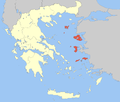North Aegean
North Aegean
Περιφέρεια Βορείου Αιγαίου | |
|---|---|
 | |
| Coordinates: 38°42′N 26°00′E / 38.7°N 26.0°ECoordinates: 38°42′N 26°00′E / 38.7°N 26.0°E | |
| Country | |
| Decentralized Administration | Aegean |
| Capital | Mytilene |
| Regional units | |
| Government | |
| • Regional governor | (New Democracy) |
| Area | |
| • Total | 3,835.91 km2 (1,481.05 sq mi) |
| Population (2011)[1] | |
| • Total | 199,231 |
| • Density | 52/km2 (130/sq mi) |
| Time zone | UTC+2 (EET) |
| • Summer (DST) | UTC+3 (EEST) |
| ISO 3166 code | GR-K |
| HDI (2019) | 0.852[2] very high · 7th |
| Website | www |
The North Aegean Region (Greek: Περιφέρεια Βορείου Αιγαίου, romanized: Periféria Voríou Eyéou, [periˈferia voˈriu eˈʝeu]) is one of the thirteen administrative regions of Greece, and the smallest of the thirteen by population. It comprises the islands of the north-eastern Aegean Sea, called the North Aegean islands, except for Thasos and Samothrace, which belong to the Greek region of Eastern Macedonia and Thrace, and Imbros and Tenedos, which belong to Turkey.
Administration[]
The North Aegean region was established in the 1987 administrative reform. With the 2010 Kallikratis plan, its powers and authority were redefined and extended. Along with the Southern Aegean region, it is supervised by the Decentralized Administration of the Aegean based at Piraeus. The capital of the region is situated in Mytilene on the island of Lesbos.
Until the Kallikratis reform, the region consisted of the three prefectures of Samos, Chios and Lesbos. Since 1 January 2011 it is divided into five regional units: Chios, Ikaria, Lemnos, Lesbos and Samos.[3] The total number of islands in the North Aegean region are nine: Lesbos, Chios, Psara, Oinousses, Ikaria, Fournoi Korseon, Lemnos, Agios Efstratios and Samos.
Major communities[]
- Chíos (Χίος)
- Kalloní (Καλλονή)
- Karlóvasi (Καρλόβασι)
- Mýrina (Μύρινα)
- Mytilíni (Μυτιλήνη)
- Omiroúpoli (Ομηρούπολη)
- Pythagóreio (Πυθαγόρειο)
- Vathý (Βαθύ)
Economy[]
The Gross domestic product (GDP) of the region was 2.5 billion € in 2018, accounting for 1.4% of Greek economic output. GDP per capita adjusted for purchasing power was 14,200 € or 47% of the EU27 average in the same year. The GDP per employee was 67% of the EU average. North Aegean is the region in Greece with the lowest GDP per capita and one of the poorest regions in the EU.[4]
References[]
- ^ "Demographic and social characteristics of the Resident Population of Greece according to the 2011 Population - Housing Census revision of 20/3/2014" (PDF). Hellenic Statistical Authority. 12 September 2014. Archived from the original (PDF) on 8 September 2015.
- ^ "Sub-national HDI - Area Database - Global Data Lab". hdi.globaldatalab.org. Retrieved 2021-07-20.
- ^ "ΦΕΚ A 87/2010, Kallikratis reform law text" (in Greek). Government Gazette.
- ^ "Regional GDP per capita ranged from 30% to 263% of the EU average in 2018". Eurostat.
External links[]
| Wikimedia Commons has media related to North Aegean. |
- Official website
 (in Greek)
(in Greek)
- North Aegean
- NUTS 2 statistical regions of the European Union
- States and territories established in 1987
- Administrative regions of Greece
- 1987 establishments in Greece

